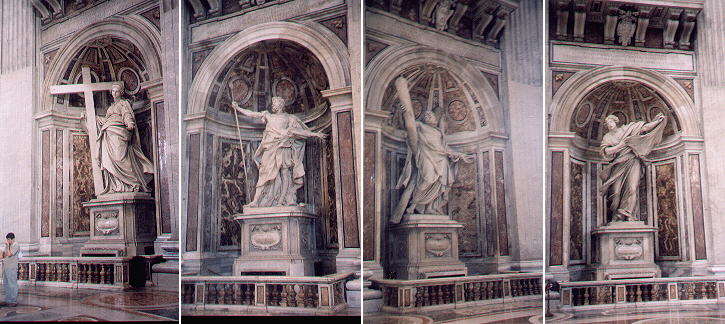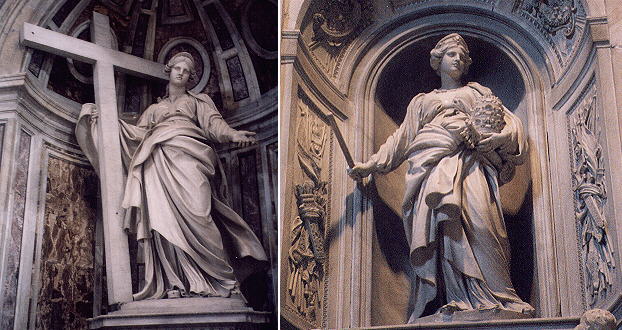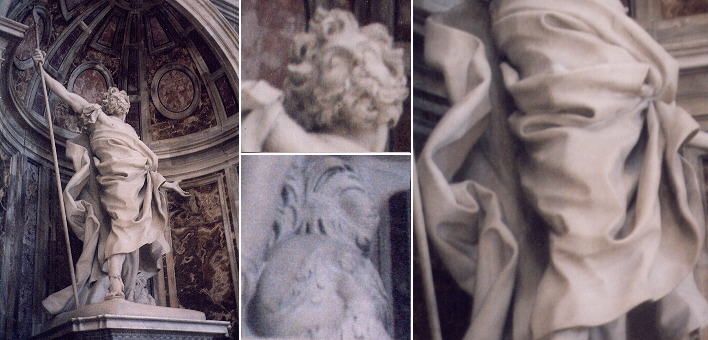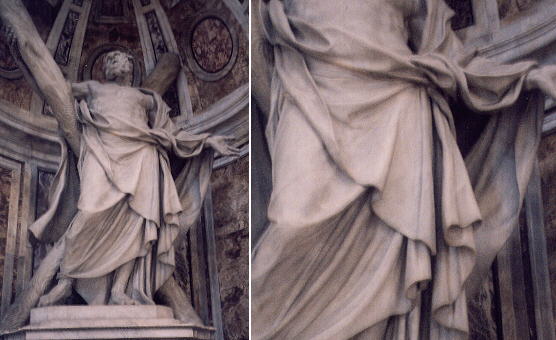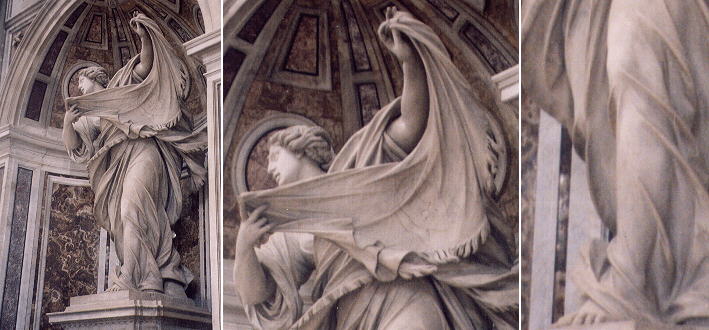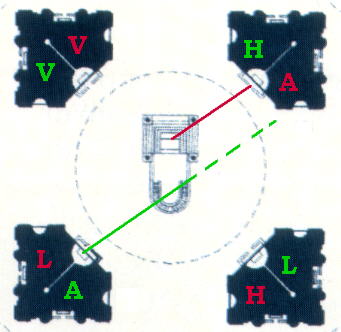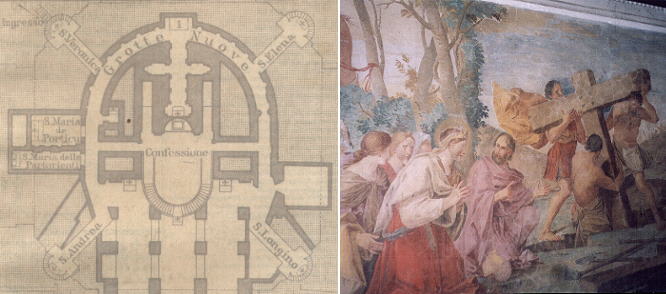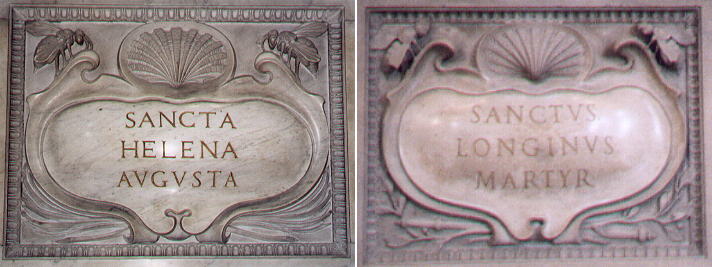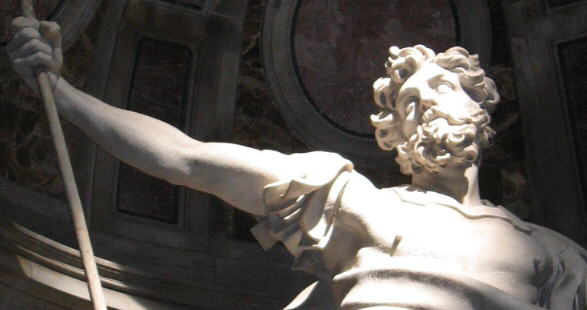  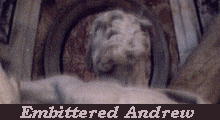 The statues in the octagon of St. Peter's The statues in the octagon of St. Peter's
In 1623 when Cardinal Matteo Barberini was elected pope (Urbanus VIII) the new St. Peter's was finished from a structural viewpoint. The immense building however was almost
entirely empty: of his predecessors only Paulus III and Gregorius XIII had arranged to be buried in the new basilica in a monumental fashion.
Urbanus VIII endorsed Bernini's suggestion and in that same year the four relics were selected: because the Colonna Santa was already represented by the baldacchino, it was excluded
from the list: the four relics chosen were:
Andrea Bolgi from Carrara, the town in Tuscany known for its marble quarries, designed a very
classical St. Helena where only the controlled
movement of the dress tells the viewer that he is looking at a XVIIth century sculpture. But Andrea Bolgi was not
departing from the path set for him by Gian Lorenzo Bernini: Bernini too in the 1630s was having a sort of "classical period" and his statue
of Countess Matilda of Tuscany (completed in 1637 and located in the right nave of St. Peter's) is very similar to St. Helena, which was completed in 1639.
Bernini designed this statue 22 times discussing the various alternatives with the pope himself. The full scale stucco model was finally endorsed by the pope in 1632. The marble statue was completed by Bernini in May 1638, the first of the four statues to be completed. By using several blocks of marble Bernini portrayed St. Longinus with his left hand fully stretched in the moment he recovers his sight. The left leg is stretched too and the foot is right on the edge of the pedestal. The statue has a "main view" (small image with the other statues) meant for the visitor who enters the octagonal area. The visitor who leaves the area and heads towards the exit sees another "preferred view" (large image here above) of the statue. The Spirit of God in the form of a strong wing animates the cloak of the centurion, ruffles his hair and the feathers of his elaborate helmet.
François Duquesnoy, with the painters Claude Poussin and Andrea Sacchi and the sculptor Alessandro Algardi, was a supporter of a neat style aimed at reaching the composed majesty of the ancient statues. Gian Lorenzo Bernini did not lean towards theoretical discussions: he had a very pragmatic approach: he continuously tested through sketches and models the final effect of his works until he was fully satisfied with the result. Having tested the skills of Duquesnoy in some details of the baldacchino, Bernini included the Flemish sculptor in the quartet in charge of the statues. Duquesnoy designed a statue which in a way is a summary of both Baroque and classical tendencies. The lower part of the statue is very classical and it is based on ancient statues portraying Jupiter and the cloak of the saint falls according to gravity laws. The upper part instead is very theatrical with the head and the arms arranged in the same way Bernini arranged those of St. Longinus.
But one fails to understand why the saint is portrayed in such a dramatic way (it is after this statue that when a toreador holds the red cloth with both hands and shakes it before the bull, that figure is called veronica).
When Gian Lorenzo Bernini was about to complete his statue an ecclesiastical commission advised the pope that the positioning of the four statues established in 1628 was not the most appropriate and that rather than positioning St. Andrew to the right of the baldacchino it was preferable to position there St. Helena which, besides representing the most cherished relic, was also a metaphor of religion itself. The change involved also St. Longinus. The plan above summarizes the changes. This explains why St. Andrew now looks towards the right transept rather than towards the baldacchino as planned by Duquesnoy.
In the ten years between the initial and the final decision many activities had already been completed in the Vatican Grottoes to prepare the four altars below the statues. The corridors leading to the altars had been painted with episodes related to the relic celebrated in the altar: this explains why the corridor leading to the Lance of St. Longinus is painted with episodes showing St. Helena retrieving the Cross.
The fine pedestals designed by Bernini and decorated with the heraldic bees of the pope most likely were already in place in 1638: the pedestal of St. Helena is decorated with palm leaves which are a symbol of martyrdom, but the mother of Constantine died in her bed at the age of 83 (by the way when she made her trip to the Holy Land to search for the cross she was 80 years old and not the rather young woman portrayed by sculptors and painters), while the pedestal of St. Longinus, a martyr, is decorated with a sceptre, a sign of authority and a likely attribute of St. Helena.
François Duquesnoy did not believe that the change decided in 1638 was truly due to religious reasons. He suspected that Bernini had promoted the change to place his St. Longinus in a location having a better light. The four niches have very different lighting conditions with the niche of St. Helena getting a lot of reflected light from the marble pavement of the main nave and direct light in the morning from the windows of the dome. St. Longinus gets less light from the main nave but in the afternoon it is directly lit by the windows of the dome. St. Andrew and St. Veronica get direct light only in the period close to the summer solstice. Duquesnoy was almost obsessed by the change affecting the statue upon which he relied for his posterity. He died in 1643 with this grief. Every morning a ray of light moves through the apse attracting the attention of the viewer to a specific work of art (in the image above left to right: the angels of the Confession, St. Ambrose, the coat of arms of Urbanus VIII - all by Bernini - , the hand of St. Elia by Agostino Cornacchini) and finally it is the turn of St. Helena. When this occurs St. Andrew has an even more desperate look. And in the afternoon it is the turn of St. Longinus!!
P. S.: a few words on two relics. The head of St. Andrew and the fragment of the Lance shed some light on the relationships between the popes and the Turkish sultans after the fall of Constantinople in 1453. The head of St. Andrew was kept in the cathedral of Patrasso where the saint was put to death in 60 A.D. At the fall of Constantinople in 1453 the Byzantine Empire consisted of the city and its immediate surroundings and of the despotate of Mistra which included Patrasso. In 1460 the Turks invaded this last Byzantine possession and the relic was moved away from Patrasso to prevent its falling into Turkish hands. The heirs of the Byzantine Empire in the attempt to foster a crusade against the Turks decided to bequeath the relic to Pope Pius II. The head of St. Andrew arrived in Rome from Ancona in 1462 and it was met by Cardinal Bessarione at Ponte Milvio. Pope Pius II managed to join Venice and Hungary in an agreement against the Ottomans with the final goal of returning Constantinople and its environs to the surviving members of the Byzantine ruling house. Actual hostilities began in September 1463 when the Venetians seized a number of Aegean Islands as well as much of Morea. The Pope moved to Ancona where he tried to assemble a sort of crusader army but he died there in 1464 . The war went on until 1479 with Venice eventually forced to reach a settlement. Thirty years later, in 1492, a fragment of the Lance was presented to Pope Innocentius VIII by the Sultan's envoy Chamisbuergh and it arrived in Rome following the same itinerary as that of the previous relic. By this present Sultan Bayezit II was trying to influence the pope and ensure he did not support his junior brother and rival Cem Sultan, who, after a failed attempt to dethrone Bayezit, had sought refuge in Malta and later in Rome, where he had been treated as a possible Christian Sultan. Because the authenticity of the relic and in general of the events related to St. Longinus were rather dubious, the episodes painted in the Grottoes are mainly related to the procession accompanying the relic on its journey to Rome, rather than to St. Longinus. Note: In 1966 Pope Paulus VI decided to return the head of St. Andrew to Patrasso as part of an overall action to improve relations with the Greek Orthodox Church. Other pages dealing with Baroque sculpture: Statues in the act of praying Monuments showing the dead in a medallion Representation of Death in Baroque sculptures Three busts by Alessandro Algardi Baroque Angels Three chapels by Gian Lorenzo Bernini Baroque Monuments to the Popes Baroque High Reliefs Statues Close to Heaven Laughing Masks Playing with Colours Other pages dealing with St. Peter's: Scala Regia A Laborious Delivery It wasn't done in a day! See also my List of Baroque Architects and my Directory of Baroque Sculpture.
Go to my Home
Page on Baroque Rome or to my Home Page on Rome
in the footsteps of an XVIIIth century traveller.
|
All images © 1999 - 2003 by Roberto Piperno. Write to romapip@quipo.it
